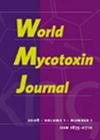An investigation of different antimycotoxin additives in swine intestinal explants challenged with aflatoxin and fumonisin: ex vivo and in vitro models
IF 2.2
4区 医学
Q3 FOOD SCIENCE & TECHNOLOGY
引用次数: 0
Abstract
This study aimed to develop an ex vivo model to evaluate the efficacy of antimycotoxin additives (AMAs) against aflatoxin B1 (AFB1) and fumonisin B1 (FB1) using intestinal explants of growing pigs. Four assays of two treatments with 12 replicates each (24 jejunal explants used per assay) were performed using an Ussing Chamber (UC) system: two assays to evaluate two AMAs for AFB1 and two assays to evaluate two AMAs for FB1. The difference between the two assays for both AFB1 and FB1 was the composition of the additive used. The treatments for AFB1 assays were control [Buffer solution (BS) + 1 mg/l AFB1] and AMA (BS + 1 mg/l AFB1 + 0.5% AMA 1 or 2). The treatments for FB1 assays were control (BS + 50 mg/l FB1) and AMA (BS + 50 mg/l FB1 + 0.5% AMA 3 or 4). The efficacy of the four additives was also tested in vitro. The AFB1 concentrations in the explants from AMAs 1 and 2 were lower () than in the control. AMAs 1 and 2 reduced the jejunal absorption of AFB1 by 83.4 and 72.9%, respectively. Explants from AMAs 3 and 4 had lower FB1 () concentration when compared to the respective control treatment. AMAs 3 and 4 reduced the FB1 absorption by 31.9 and 17.6%, respectively. In the in vitro test, AMAs 1 and 2 provided 98.4 and 86.3% of AFB1 adsorption, respectively, while AMA 3 and 4 provided 91.2 and 80.5% FB1 adsorption, respectively. The ex vivo model can be a useful tool in evaluating the effectiveness of antimycotoxin additives for AFB1 and FB1 in swine. However, the low FB1 uptake in jejunal explants highlights the need for the development of additional information to improve the method.不同抗霉菌毒素添加剂在受到黄曲霉毒素和伏马菌素挑战的猪肠外植体中的应用研究:体外和体内模型
本研究旨在开发一种体内外模型,利用生长猪的肠道外植体来评估抗霉菌毒素添加剂(AMA)对黄曲霉毒素 B1(AFB1)和伏马菌素 B1(FB1)的功效。使用乌星试验箱(UC)系统对两种处理进行了四次试验,每次试验有 12 个重复(每次试验使用 24 个空肠外植体):两次试验评估两种 AMA 对 AFB1 的作用,两次试验评估两种 AMA 对 FB1 的作用。AFB1 和 FB1 两种检测方法的不同之处在于所用添加剂的成分。AFB1 试验的处理为对照组 [缓冲溶液 (BS) + 1 毫克/升 AFB1] 和 AMA(BS + 1 毫克/升 AFB1 + 0.5% AMA 1 或 2)。FB1 试验的处理为对照(BS + 50 mg/l FB1)和 AMA(BS + 50 mg/l FB1 + 0.5% AMA 3 或 4)。四种添加剂的功效也在体外进行了测试。与对照组相比,AMA 1 和 2 的外植体中的 AFB1 浓度较低()。AMAs 1 和 2 可将空肠对 AFB1 的吸收率分别降低 83.4% 和 72.9%。与各自的对照处理相比,AMA 3 和 4 的外植体的 FB1()浓度较低。AMAs 3 和 AMAs 4 可使 FB1 的吸收率分别降低 31.9% 和 17.6%。在体外试验中,AMA 1 和 2 对 AFB1 的吸附率分别为 98.4% 和 86.3%,而 AMA 3 和 4 对 FB1 的吸附率分别为 91.2% 和 80.5%。该体内外模型是评估抗霉菌毒素添加剂对猪体内 AFB1 和 FB1 的有效性的有用工具。然而,空肠外植体对 FB1 的吸收率较低,这突出表明需要开发更多信息来改进该方法。
本文章由计算机程序翻译,如有差异,请以英文原文为准。
求助全文
约1分钟内获得全文
求助全文
来源期刊

World Mycotoxin Journal
MYCOLOGY-
CiteScore
4.60
自引率
5.00%
发文量
25
审稿时长
>12 weeks
期刊介绍:
''World Mycotoxin Journal'' is a peer-reviewed scientific journal with only one specific area of focus: the promotion of the science of mycotoxins. The journal contains original research papers and critical reviews in all areas dealing with mycotoxins, together with opinions, a calendar of forthcoming mycotoxin-related events and book reviews. The journal takes a multidisciplinary approach, and it focuses on a broad spectrum of issues, including toxicology, risk assessment, worldwide occurrence, modelling and prediction of toxin formation, genomics, molecular biology for control of mycotoxigenic fungi, pre-and post-harvest prevention and control, sampling, analytical methodology and quality assurance, food technology, economics and regulatory issues. ''World Mycotoxin Journal'' is intended to serve the needs of researchers and professionals from the scientific community and industry, as well as of policy makers and regulators.
 求助内容:
求助内容: 应助结果提醒方式:
应助结果提醒方式:


